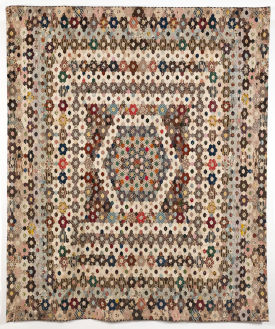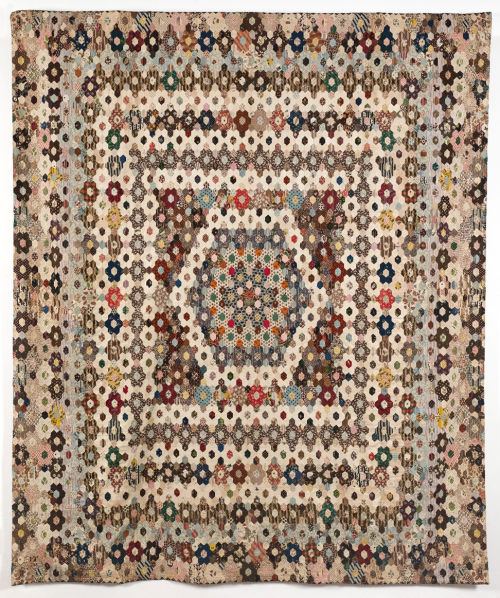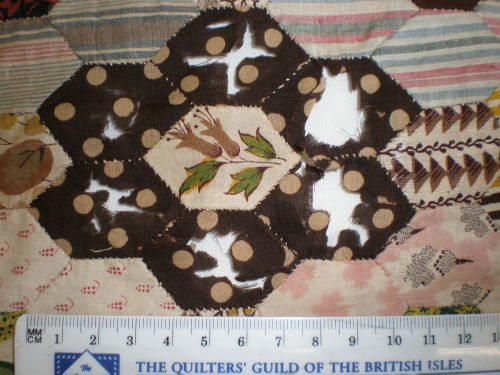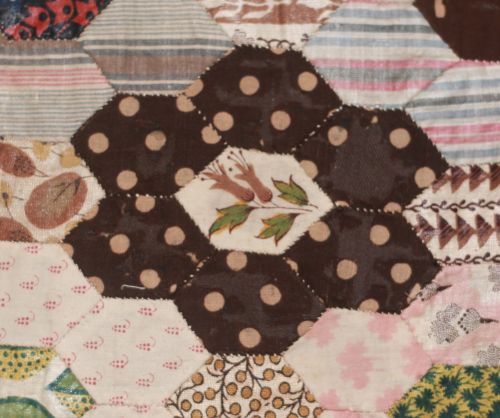September Quilt of the Month - The Mary Prince Coverlet
Published: Saturday, 1st September 2012 00:01 AM

September Quilt of the Month - The Mary Prince Coverlet
The Mary Prince Coverlet is a mosaic patchwork coverlet made from pieced printed cotton hexagons arranged in a complex frame design. The papers which would have been used in its original construction have been removed. Linen tapes edge the coverlet on the back, and the embroidered name and date of the maker ‘Mary Prince 1803’ feature on one edge. The coverlet contains a vast range of printed cottons, in many colours and designs, and the careful tonal arrangement of the hexagon rosettes have created a stunning piece which must be admired for both its beauty and its geometric skill.
Fabric Dating
This quilt is something of a puzzle, and research into fabric dyes, patterns and overall design has revealed many interesting facts. In 2001, Deryn O’ Connor and Tina Fenwick-Smith from The Quilters’ Guild Heritage Committee carefully examined the fabrics and designs of the coverlet. Through close examination, they found the earliest fabrics dated from the 1780s, and at least 25 fabrics in the quilt showed blue threads in the selvedge. This is significant for dating, as between 1774 and 1811, weavers in Britain were required by law to include three blue threads in the selvedge for tax purposes. There are also some Indian painted chintz samples, and some strong yellow coloured fabrics, which were made possible by the introduction of quercitron dye from America in 1785. The careful examination also revealed that many of the fabric pieces showed signs of seams and previous use.
Interestingly, although the piece is dated in blue cross stitch as ‘1803’, and evidence from the fabrics of the outer frames confirms a date range of 1785-1805, the inner patchwork pieces contradict that original dating. The central section contains a very different colour range and there are some hexagons in the centre made from the Lapis printing technique. This technique enabled different colours to be placed alongside each other without gaps or overprinting, but it wasn’t invented until 1808. It seems this coverlet was constructed with materials from a wide range of different dates, and the centre contains the later fabrics, with the older ones being used for the outer frames.
It has been suggested that the reason for the confusing construction of new fabrics in the centre and old fabrics in the outer frames could be that the maker wanted the most fashionable and up-to-date fabrics as a central focal point. Alternatively, it could be that the whole centre section, which contains the more recent fabrics and has a distinctly different look to the rest of the quilt, could have replaced a damaged section of the original quilt, therefore accounting for the difference in dating.
Until very recently, this coverlet was in too fragile a condition to be put on public display but thanks to funding from the AIM Pilgrim Trust Conservation Grant, The Quilters’ Guild was able to have this coverlet professionally conserved in 2009. The coverlet has been cleaned, the damaged areas supported and a linen backing put on to provide stability.
Research into the fabrics was undertaken in 2001 by Tina Fenwick-Smith and Deryn O’Conner, and the published article of their findings can be found in The Quilter, No.88, Autumn 2001
 The Mary Prince Coverlet
The Mary Prince Coverlet
 Example of a damaged section before conservation
Example of a damaged section before conservation
 A damaged section of the coverlet after conservation
A damaged section of the coverlet after conservation